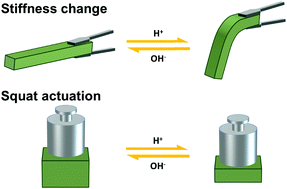Osmotic squat actuation in stiffness adjustable bacterial cellulose composite hydrogels
Abstract
Mechanically adaptive hydrogels can change their mechanical characteristics in response to external stimuli and have potential applications in biomechanical fields. To eliminate the undesired swelling/shrinkage in the responding process, poly(acrylic acid) (PAA) was grafted to acryloyl chloride (AC)-modified bacterial cellulose (BC) by free-radical polymerization. The obtained BC-g-PAA composite hydrogels showed adjustable stiffness in compression, remained soft at pH lower than 6 (compression strain over 49% at a stress of 0.1 MPa), and stiffened when pH reached 7 (compression strain lower than 27% at a stress of 0.1 MPa), while the volume change ratio was consistently lower than 15%. Based on this, the hydrogels showed interesting squat actuation to lift a weight. The BC composite hydrogels exhibited dual pH-responsiveness after grafting PAA with poly[2-(dimethylamino)ethyl methacrylate], confirming the general availability of this strategy in fabricating volumetrically stable and mechanically adaptive hydrogels. The surrounding solution-independent softening of BC-g-PAA hydrogels was observed in 8 min under UV irradiation via a photo-triggered pH jump reaction. By virtue of the selective UV irradiation, spatiotemporally controllable softening with actuation in BC-g-PAA hydrogels was realized. The developed pH-responsive mechanically adaptive BC composite hydrogels with high dimensional stability and UV-activated spatiotemporal squat actuating capability are expected to provide more options in developing novel bioimplants and smart structures.



 Please wait while we load your content...
Please wait while we load your content...